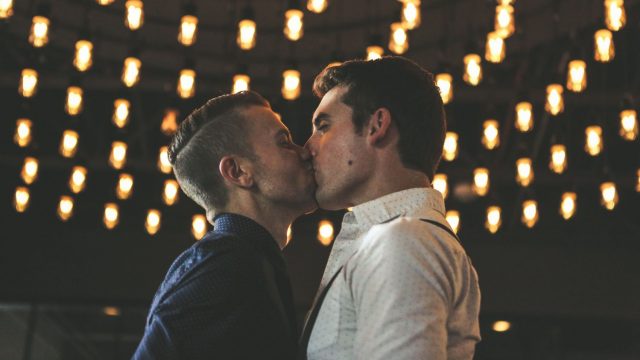
Plus: A four-point guide to navigating all things queer nuptials.
At our third tasting, I texted my fiancé, Nate, from under the table.
“What’s actually happening?”
We were seated at a restaurant that could potentially cater our wedding. But for the past 20 minutes, the caterer had only been addressing the straight couple seated next to us. The man—tall and proper, if not a bit stiff—was going on about cancellation policies, that toddlers didn’t count toward the final guest count, and how you should bring your own gallon-size Ziploc bags to take home the leftovers (“We don’t prepare takeaway boxes.”) Without ever looking at me or Nate once, the caterer began discussing chicken. Considering we had told them we wanted a vegan menu, this seemed particularly strange.
Then, as if perfectly rehearsed, plates of hot chicken and buttered vegetables piled out of the kitchen and landed on the white table cloth before us.
Nate, bless his big heart, finally spoke up.
“I’m sorry, I think there’s been a mistake. We’re a couple—and he’s vegan.” The caterer turned scarlett with embarrassment.
“I didn’t know you two were a couple,” he said. “I didn’t know what the relationship was here.”
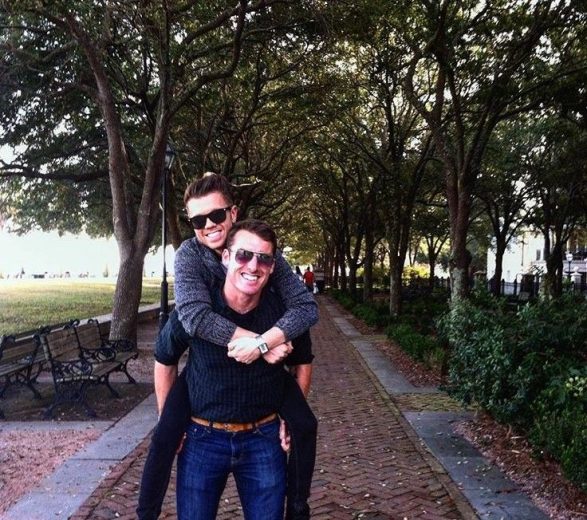 He did not mean to offend, and quickly went on to explain that he’d assumed we were guests of the happy heterosexual couple by our side. And though he offered to schedule us a different tasting specific to our needs and diet, we politely declined.
He did not mean to offend, and quickly went on to explain that he’d assumed we were guests of the happy heterosexual couple by our side. And though he offered to schedule us a different tasting specific to our needs and diet, we politely declined.
The truth was all too clear: The fact that this caterer’s customers could very well be two husbands had never crossed his mind. But he’s not the only one.
With only 278 days until I tie the knot, my wedding website insists on reminding me that Nate hasn’t yet found his wedding dress. He should have at least started shopping by now, the website’s handy checklist pesters. It even offers to help Nate and me get started with three “recommended” bridal salons for his (our?) dress(es). Neither Nate nor I plan on wearing an ivory gown down the aisle (though I wouldn’t object if he wanted to). For one, I’d unquestionably spill barbecue sauce on it. And two, Nate’s ass looks much better in pants.
To the chagrin of my wedding website and a score of vendors, there will be no brides at our wedding, no bridal parties, no veils or bouquets, and that’s a hard fact for many in the wedding business to acknowledge.
Same-sex weddings are nothing new, having been legal in at least some parts of the United States for nearly 14 years now. As same-sex weddings become increasingly more common, it’s similarly becoming increasingly unlikely you and your betrothed will have to defend yourself from slurs or outright refusals (though that’s certainly never a given). But that doesn’t mean wedding planning for gay couples is suddenly easy or problem-free. Just because a baker doesn’t etch faggot into your icing doesn’t mean you’re in the clear.
Ilan H. Meyer, a scholar at the Williams Institute for Sexual Orientation Law and Public Policy at the University of California Los Angeles’ School of Law, notes how legislation doesn’t always shift culture right away.
“People’s attitudes don’t change as fast as laws can change,” he tells me.
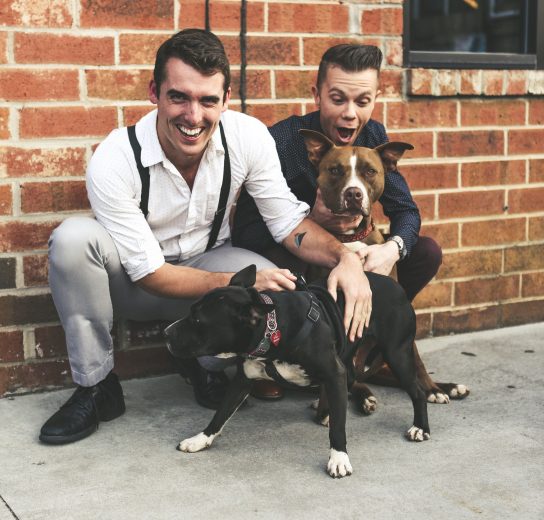 While no vendor has come close to throwing slurs at Nate and me or refusing to arrange our flowers, at each wedding venue we visited, employees showed us where the bride would come out, where the bridal party would follow, and where the bridal party would stowaway to prepare for the day in a maelstrom of hairspray and blush. It’s no secret Nate and I are the engaged ones. We’ve never brought along a woman with us to these venues. Yet, old habits die hard, and it’s the bride’s day, still.
While no vendor has come close to throwing slurs at Nate and me or refusing to arrange our flowers, at each wedding venue we visited, employees showed us where the bride would come out, where the bridal party would follow, and where the bridal party would stowaway to prepare for the day in a maelstrom of hairspray and blush. It’s no secret Nate and I are the engaged ones. We’ve never brought along a woman with us to these venues. Yet, old habits die hard, and it’s the bride’s day, still.
“Homophobia has been connected with seeing gay people being almost incapable and really not deserving of relationships, and I think that’s harder to overcome with legislation alone,” Meyer says. “There’s a process through which culture and society adjusts itself.”
And so it seems, even with the Supreme Court ruling behind us, Nate and I have started to plan our wedding with those who are still adjusting. While I doubt any of these people intend for their language to offend or upset us, it does create an undeniable feeling of inferiority, of crashing a party at which we don’t belong.
 “It’s more than annoying. It’s a sign of exclusion,” Robin Simon, a sociology professor at Wake Forest University, says. “It’s insidious.” Simon also explains that awkwardness is more than just a thorny conversational issue: It can affect a person’s physical and emotional well-being. “We do have legal marriage protections for LGBT people, but de facto we don’t. And that’s very unfortunate,” Simon says. “There’s no doubt this has emotional consequences for people who have the right to marry, but who often struggle when making arrangements.”
“It’s more than annoying. It’s a sign of exclusion,” Robin Simon, a sociology professor at Wake Forest University, says. “It’s insidious.” Simon also explains that awkwardness is more than just a thorny conversational issue: It can affect a person’s physical and emotional well-being. “We do have legal marriage protections for LGBT people, but de facto we don’t. And that’s very unfortunate,” Simon says. “There’s no doubt this has emotional consequences for people who have the right to marry, but who often struggle when making arrangements.”
Knowing you might encounter some of the same issues during your wedding planning, here’s a four-point a guide I’ve found helpful throughout the process.
1. Speak up
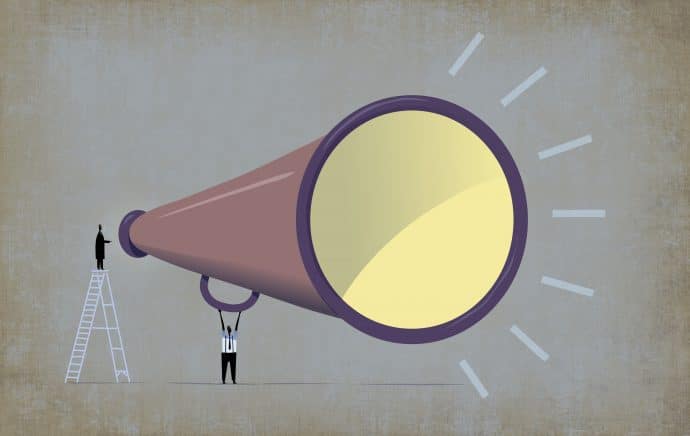 I wasn’t offended when our venue tour guide continued to show us where the bride would walk out or where the bridal party would make its entrance. But I also didn’t let it hang in the air; I kindly clarified that we were two grooms. A simple, polite reminder usually does the trick and lets the person know to be more careful with his or her language.
I wasn’t offended when our venue tour guide continued to show us where the bride would walk out or where the bridal party would make its entrance. But I also didn’t let it hang in the air; I kindly clarified that we were two grooms. A simple, polite reminder usually does the trick and lets the person know to be more careful with his or her language.
If you want to add some levity to the situation, but still get your point across, ask something like: “Where will both grooms walk out?” or “What if there are two brides?”
2. Talk to someone
 Both Meyer and Simon say there are people–therapists, psychologists, counselors, etc.–with whom you can speak to if the stressors are too great for you to handle on your own.
Both Meyer and Simon say there are people–therapists, psychologists, counselors, etc.–with whom you can speak to if the stressors are too great for you to handle on your own.
“Large-scale inequalities get under your skin and into your heart and mind,” Simon explains. “It’s perfectly normal to seek out a professional’s help in coping with these stressors.”
Consider reaching out to your trusted social network for a referral, or connect with your local LGBT center that can recommend experienced mental health counselors for you to see individually or with your partner.
3. Don’t let anyone rain on your parade
 Above all, this is your day. You’re celebrating love, which is something the world needs a lot more of. Take solace in knowing your honeymoon awaits, which is just one more reason to celebrate. And if all else fails, take a good look at your fiancé’s killer ass in those snug pants and, remember, you’re getting legally married!
Above all, this is your day. You’re celebrating love, which is something the world needs a lot more of. Take solace in knowing your honeymoon awaits, which is just one more reason to celebrate. And if all else fails, take a good look at your fiancé’s killer ass in those snug pants and, remember, you’re getting legally married!
4. Find your allies
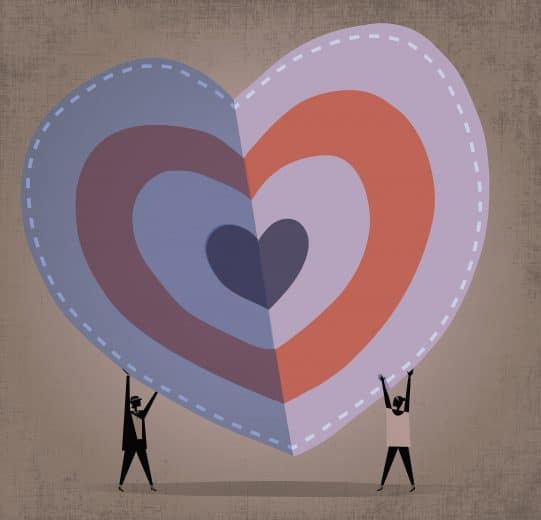 The best thing a couple can do to avoid awkward situations is to not only find a vendor that accepts them, but one that openly and explicitly welcomes same-sex couples.
The best thing a couple can do to avoid awkward situations is to not only find a vendor that accepts them, but one that openly and explicitly welcomes same-sex couples.
“Search for those companies who are inclusive,” Simon says. “Don’t give your business to those companies who narrowly define their view of marriage. The power of the purse is what could change things.”
Nate and I did just that when the first few websites we visited to find the perfect save-the-date card only featured heterosexual couples in their samples. We ultimately found a more inclusive company.
But for those companies mired in their narrow views of marriage? Simon has more flavorful words for them.
“Fuck ’em. Just go to someone else!”







